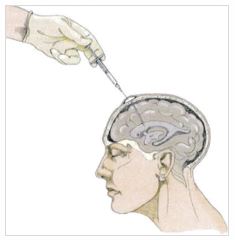Scripps Cancer Center
| |
|
 |
|
| |
|
Ommaya Reservoir |
|
Ommaya Reservoir
How an Ommaya reservoir works:
An Ommaya reservoir has two parts. The first part is a small, silicone, dome-like device called a port. It is implanted under the scalp. The second part is a thin, soft, plastic tube called a catheter. The catheter tubing is inserted into an area within the brain called the ventricle. This is where cerebrospinal fluid (CSF) is made. The Ommaya reservoir is put in place in the operating room. The Ommaya reservoir is usually left in place permanently unless problems occur. The dome of the device creates a slight, soft bulge on the scalp about the size of a quarter.
The Ommaya reservoir provides a way to:
-
Obtain long-term access to the CSF by way of the ventricles
-
Give medicine directly into the CSF of the brain and spine without having to do a lumbar/spinal injection
-
Measure the pressure of CSF
-
Obtain CSF specimens for testing
Preparing for a procedure:
-
Speak with your health care team about any medicines to avoid prior to a procedure
-
You may need lab tests done prior to a procedure via the Ommaya reservoir. Ask your health care team if this is necessary, and where and when you will go
Procedure
-
Do not touch the area once the procedure has begun. It is important to keep the area clean.
-
Scalp hair over the Ommaya is shaved when needed before using the reservoir.
-
The area is scrubbed well with an antiseptic. Tell your doctor if you are allergic to any cleansing solutions. During the procedure, your position may vary. The nurse or physician will give you further instructions.
-
There is minimal pain during this procedure, so local anesthetic is not commonly needed to numb the area.
-
A small needle is inserted into your reservoir and CSF may be removed. Then, medicine is given.
-
The procedure takes less than 1 hour.
-
After the procedure, you may need to remain lying down for a short time. Afterwards, you may start your usual activities.
-
Possible symptoms after the procedure may include nausea, vomiting, headaches, or dizziness.
-
These symptoms should only last a short time. Contact your doctor if they continue or get worse.
The Ommaya reservoir does not require special care once the incision area has healed. The area should be kept dry until the sutures are removed or have dissolved. Follow your surgeon’s instructions after surgery. You should avoid injury to the area.
Report these side effects to your doctor right away as they may be a sign of an infection or problems with your Ommaya reservoir:
-
Tenderness, redness, or drainage from the site
-
If the site is unusually warm to the touch
-
Fever of 101ºF(38.3ºC) or higher
-
Neck stiffness
-
Headache with or without vomiting
-
Pain while looking at bright lights
-
Confusion or an altered mental state